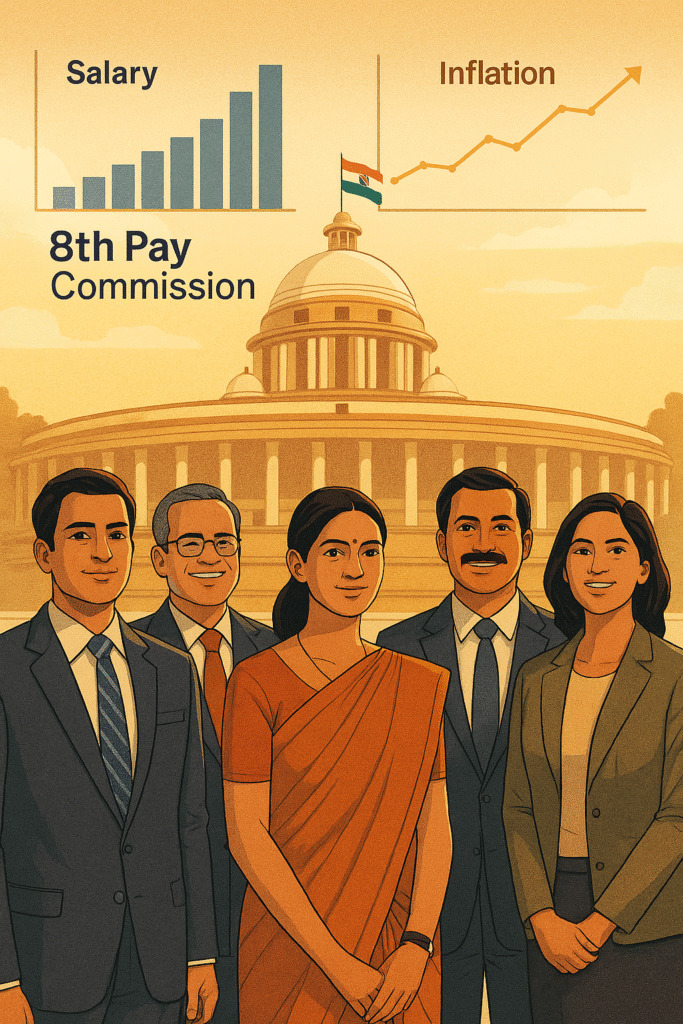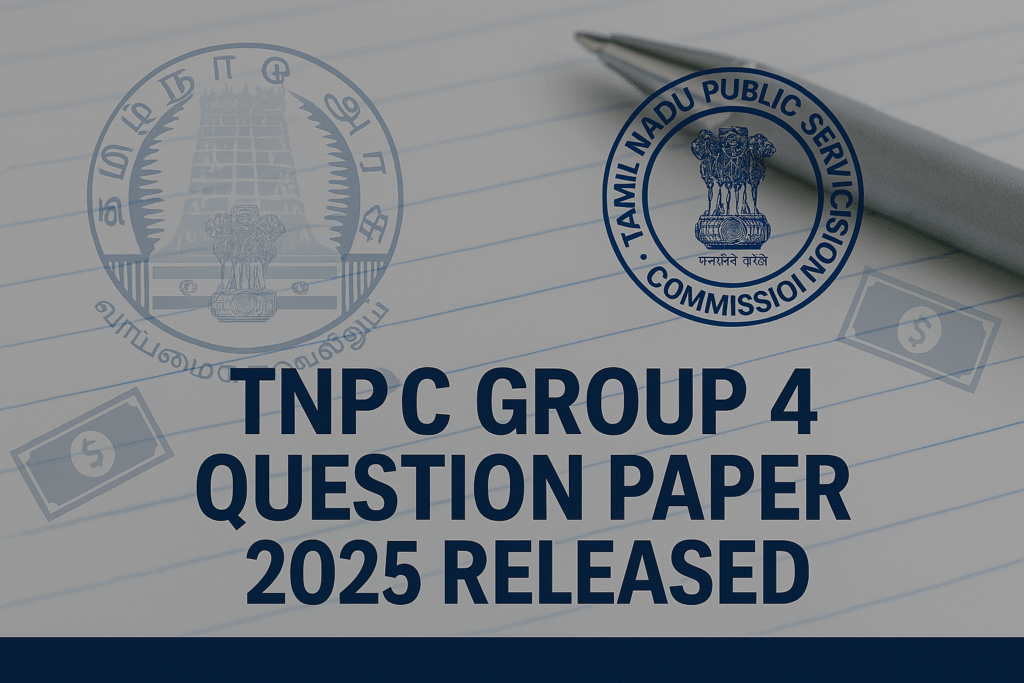Get the latest 8th Pay Commission news — from Cabinet approval to projected salary hikes, implementation timelines, and detailed pay matrix estimates for central government employees and pensioners.

Table of Contents
The 8th Pay Commission news is now the most talked-about topic among India’s central government employees and pensioners. After nearly a decade since the 7th Pay Commission, the Modi-led government has officially approved the Terms of Reference (ToR) for the 8th Central Pay Commission (8th CPC), marking a historic milestone in India’s administrative and financial reform cycle.
This comprehensive guide explains everything you need to know — from the latest announcements, expected implementation date, projected salary increases, and how the 8th Pay Commission salary calculator works — to help every government employee understand what’s coming next.
Introduction
The announcement of a new pay commission is always significant in India’s public sector ecosystem. With millions of central employees, defense personnel, and pensioners dependent on government pay structures, even a minor revision has wide-ranging economic and social effects.
The 8th Pay Commission latest news confirms that the government has now moved ahead with formal procedures. The Commission will evaluate pay scales, pensions, and allowances while balancing economic realities and inflation. The goal is to ensure fair remuneration, reward performance, and maintain parity across various government sectors.
What Is the 8th Pay Commission and Why It Matters
The 8th Pay Commission (8th CPC) is a government-appointed expert panel responsible for reviewing and recommending new pay structures for all central government employees and pensioners. It succeeds the 7th CPC, which came into effect on 1 January 2016.
Key Objectives of the 8th CPC
Re-evaluate basic pay and grade structure for employees.
Review allowances such as HRA, DA, and TA in line with inflation.
Reassess pensions for retired employees.
Recommend performance-linked incentives for select roles.
Ensure fiscal sustainability while improving public service motivation.
The pay commission serves as a bridge between economic growth and equitable compensation. With the cost of living rising sharply, this exercise is vital for maintaining employee morale and national productivity.
What the Government Has Approved
According to the latest 8th Pay Commission news, the Union Cabinet has approved the Terms of Reference (ToR) for the 8th CPC. This approval allows the Finance Ministry to formally constitute the commission, appoint its members, and begin analytical work.
Major Highlights of the Cabinet Approval
Timeline: The commission will be required to submit its report within 18 months of formation.
Effective Date: The revised pay structure is expected to be implemented from 1 January 2026.
Scope: The 8th CPC will review the pay, allowances, and pension structure of central government employees and pensioners, including those in autonomous organizations.
Economic Context: The Commission must account for fiscal prudence, inflation trends, and the government’s long-term economic goals.
Chairperson and Members: The names are expected to be officially notified soon by the Department of Expenditure.
Historical Timeline of Pay Commissions in India
To understand the present, it’s worth revisiting how previous pay commissions shaped government pay systems:
| Pay Commission | Year Constituted | Year Implemented | Key Highlights |
|---|---|---|---|
| 1st CPC | 1946 | 1947 | Introduced structured pay for the newly independent civil service. |
| 2nd CPC | 1957 | 1960 | Recommended a fairer ratio between minimum and maximum pay. |
| 3rd CPC | 1970 | 1973 | Introduced the concept of “Dearness Allowance” linked to cost of living. |
| 4th CPC | 1983 | 1986 | Recommended improved retirement benefits. |
| 5th CPC | 1994 | 1996 | Introduced a major salary jump; simplified pay scales. |
| 6th CPC | 2006 | 2008 | Shifted to Pay Band and Grade Pay structure. |
| 7th CPC | 2014 | 2016 | Introduced the Pay Matrix system with Fitment Factor 2.57. |
| 8th CPC | 2025 | Expected 2026 | Revised pay, allowances, and pensions under new economic realities. |
The pattern shows that each commission emerges roughly every 10 years, making 2025 the natural year for the next revision.
What to Expect from the 8th CPC
While the final report is yet to be prepared, several key expectations have already emerged among policymakers and analysts.
1. Salary Hike – The Fitment Factor
The fitment factor determines how much current basic pay will increase under the new matrix.
7th CPC fitment factor: 2.57
Expected 8th CPC fitment factor: between 2.85 and 3.00
If implemented, this could mean a minimum basic pay rise from ₹18,000 to around ₹50,000 per month for entry-level employees.
Example:
Current Basic Pay: ₹18,000
Expected Fitment: 2.85
New Basic = ₹18,000 × 2.85 = ₹51,300
Thus, salaries across the matrix could see an increase of 85–95% compared with existing levels.
2. Dearness Allowance (DA) and Inflation Indexing
The new commission is expected to simplify DA calculation. Currently, DA is revised twice a year, based on the Consumer Price Index (CPI). Under the 8th CPC, a monthly inflation-linked adjustment formula may be proposed to keep pay more responsive to economic conditions.
3. Pension Revision
Pensioners will see corresponding increases. The One Rank One Pension (OROP) principle for defense services may be further strengthened, ensuring parity between current and retired employees of similar grades.
4. Rationalization of Pay Levels
The existing 7th CPC pay matrix has 19 levels (Level 1 to Level 18 + apex scale). The 8th CPC is expected to simplify this into fewer clusters to reduce anomalies and accelerate promotions for mid-career officers.
8th Pay Commission Salary Calculator (Projected)
The 8th Pay Commission salary calculator helps employees estimate their post-revision salary using the projected fitment factor. Below is a projected pay matrix assuming a fitment multiplier of 2.85 — this is indicative only and subject to final government approval.
| Level | Existing Basic (₹) | New Basic (₹) After 2.85× | Approx. Monthly Gross (₹)* |
|---|---|---|---|
| 1 | 18,000 | 51,300 | 85,000 – 90,000 |
| 2 | 19,900 | 56,700 | 92,000 – 97,000 |
| 3 | 21,700 | 61,850 | 99,000 – 1,05,000 |
| 4 | 25,500 | 72,675 | 1,12,000 – 1,18,000 |
| 5 | 29,200 | 83,220 | 1,25,000 – 1,32,000 |
| 6 | 35,400 | 1,00,890 | 1,48,000 – 1,56,000 |
| 7 | 44,900 | 1,28,000 | 1,85,000 – 1,95,000 |
| 8 | 47,600 | 1,35,660 | 1,95,000 – 2,05,000 |
| 9 | 53,100 | 1,51,335 | 2,15,000 – 2,25,000 |
| 10 | 56,100 | 1,59,885 | 2,28,000 – 2,40,000 |
| 11 | 67,700 | 1,92,945 | 2,70,000 – 2,85,000 |
| 12 | 78,800 | 2,24,580 | 3,10,000 – 3,25,000 |
| 13 | 1,23,100 | 3,50,835 | 4,80,000 – 5,00,000 |
*Approx. Gross = Basic + DA (58%) + HRA (27%) + TA (10%)
This projection gives a broad sense of how salaries might evolve once the 8th Pay Commission latest news transitions into implementation.
Impact on Economy and Employees
The 8th CPC will influence both household and national economies.
For Employees
A direct boost in disposable income.
Greater motivation and morale among government staff.
Better retirement security through revised pension formulas.
For Economy
Increased consumption demand, particularly in urban and semi-urban areas.
Pressure on fiscal deficit and budget allocation for pay and pension.
Multiplier effect on housing, automobiles, and retail markets due to higher income levels.
Challenges Before the Commission
Despite the positive sentiment, several challenges persist:
Fiscal Responsibility: Maintaining budget discipline amid higher wage bills.
Pay Parity: Balancing differences between central and state employees.
Productivity Link: Ensuring hikes correspond to performance improvements.
Administrative Complexity: Harmonizing pay structures across thousands of departments.
The commission’s recommendations will therefore be a delicate balancing act between fiscal realism and employee welfare.
Expected Timeline of the 8th CPC
| Stage | Expected Period | Status |
|---|---|---|
| Cabinet Approval of ToR | October 2025 | ✅ Approved |
| Appointment of Commission | November – December 2025 | Pending |
| Data Collection & Analysis | January – June 2026 | Upcoming |
| Draft Recommendations | October 2026 | Expected |
| Final Report Submission | March 2027 | Likely |
| Implementation of New Pay | Mid 2027 | Tentative |
What Central Government Employees Should Do Now
While awaiting the official notification, employees can:
Keep track of official announcements through the Department of Expenditure.
Use salary calculators to estimate possible pay levels.
Update personal records for service, grade, and increment status.
Plan long-term finances considering potential arrears and revised tax slabs.
Conclusion
The 8th Pay Commission news marks a defining step in India’s evolving public-sector compensation framework. With Terms of Reference now approved and the implementation timeline in sight, millions of employees and pensioners can look forward to a significant revision in their pay and benefits from 2026 onward.
As the Commission begins its deliberations, all eyes will be on the eventual fitment factor and the degree of reform introduced in allowances and pension formulas. The 8th CPC is more than a salary adjustment—it’s a statement on the nation’s economic priorities and its commitment to employee welfare.
Focus keyword (“8th Pay Commission news”) reappears here naturally for SEO optimization.
Call to Action (CTA):
Stay tuned for future updates on the 8th CPC recommendations. Share this analysis with fellow employees and colleagues so everyone can prepare for the coming changes together.
Frequently Asked Questions (FAQs)
When will the 8th Pay Commission be implemented?
It is expected to take effect from 1 January 2026, following government approval of the Commission’s report.How much salary hike can employees expect?
Estimates suggest an 85–95% rise in basic pay if the fitment factor is around 2.85.Will pensioners also benefit from the 8th CPC?
Yes, pensions will be revised in line with new pay scales, ensuring parity with current employees.Is the 8th Pay Commission confirmed by the government?
Yes, the Union Cabinet has already approved the Terms of Reference for its constitution.
Helpful Resources













